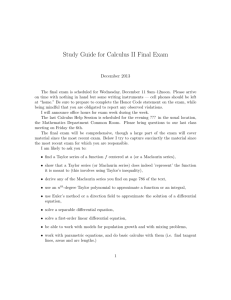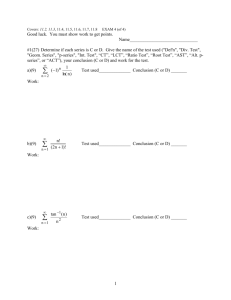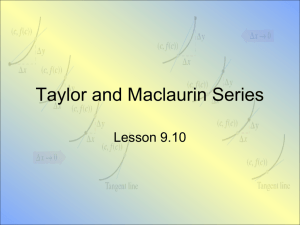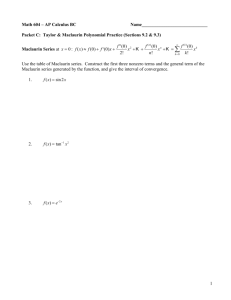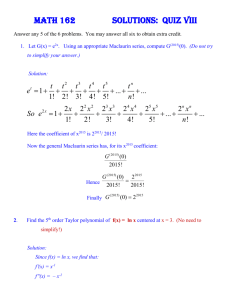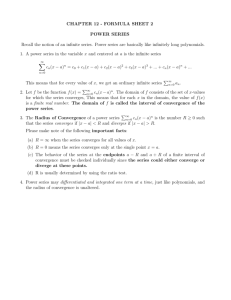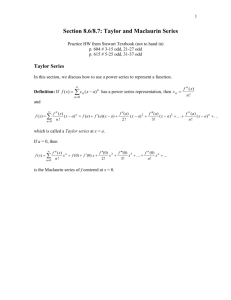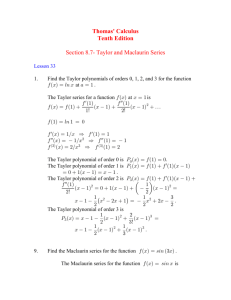9.10 - Taylor and Maclaurin Series
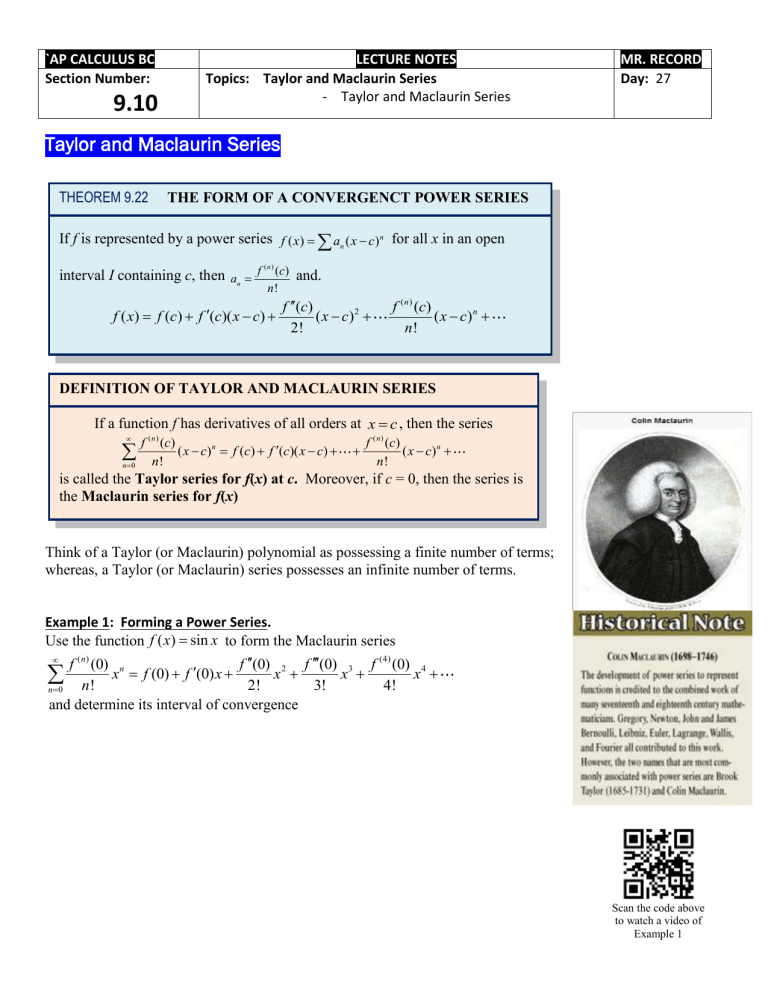
`AP CALCULUS BC LECTURE NOTES
Section Number: Topics: Taylor and Maclaurin Series
9.10
Taylor and Maclaurin Series
Taylor and Maclaurin Series
THEOREM 9.22
THE FORM OF A CONVERGENCT POWER SERIES
If f is represented by a power series
( ) interval I containing c , then a n
f ( ) n !
( )
( )
( )(
n
0 n !
2!
( )
( )(
and. f
( )
( n x c )
2
) n n !
for all x in an open
If a function f has derivatives of all orders at x
c f ( ) n !
(
) n
DEFINITION OF TAYLOR AND MACLAURIN SERIES f ( )
( x c ) n the Maclaurin series for f(x) f ( )
, then the series
( x c ) n is called the Taylor series for f(x) at c. Moreover, if c = 0, then the series is
Think of a Taylor (or Maclaurin) polynomial as possessing a finite number of terms; whereas, a Taylor (or Maclaurin) series possesses an infinite number of terms.
Example 1: Forming a Power Series.
Use the function ( )
sin x to form the Maclaurin series f n !
(0) x n f (0)
f
(0) x
f
(0) x
2
2!
f
(0) x
3
3!
f
(4)
(0) x
4
4!
n
0
and determine its interval of convergence
MR. RECORD
Day: 27
Scan the code above to watch a video of
Example 1
THEOREM 9.23
CONVERGENCE OF TAYLOR SERIES
If lim n
R n
0 for all x in the interval I , then the Taylor series for f converges and equals the ( ) given below
n
0 f ( )
( n !
) n
Example 2: A Convergent Maclaurin Series.
Show that the Maclaurin series for ( )
sin x converges to sin x
for all x .
GUIDELINES FOR FINDING A TAYLOR SERIES
1.
Differentiate ( ) several times and evaluate each derivative at c.
( ),
( ), f
( ), f
( ), f ( ),
2.
Use the sequence developed in the first step to form the Taylor coefficients, a n
series f ( )
, and determine the interval of convergence for the resulting power n !
( )
( )(
f
( )
( x c )
2
2!
f
( )
( x c )
3
3!
f ( )
( n !
) n
3.
Within this interval of convergence, determine whether the series converges to ( ) .
Example 3: Maclaurin Series for a Composite Function.
Find the Maclaurin series for f x
x
2
( ) sin .
Scan the code above to watch a video of
Example 3
AP CALCULUS BC
Section Number:
9.10
Binomial Series
LECTURE NOTES
Topics: Taylor and Maclaurin Series
Deriving a Taylor Series from a Basic List
Binomial Series
MR. RECORD
Day: 28
There is just one more type of elementary function that we have yet to discuss. That is the function of the form
( )
x
k
. This produces the binomial series .
Example 4: Binomial Series.
Find the Maclaurin series for ( ) (1 x ) k
and determine its radius of convergence. Assume k is not a positive integer. (Otherwise would we really need calculus to figure this out?)
Example 5: Finding a Binomial Series.
Find the power series for f x
3 1
x .
Write your answer as both a sum of individual terms and in summation notation.
Deriving Taylor Series from a Basic List
Example 6: Deriving a Power Series from a Basic Limit.
Find the power series for ( )
cos x .
Example 7: Multiplication and Division of Power Series.
Find the first three nonzero terms in the Maclaurin series for each of the given functions. f x
e x a.
( ) arctan x b.
( )
tan x
Example 8: A Power Series for sin 2 x.
Find the power series for f x
sin
2 x and state its interval of convergence.
AP CALCULUS BC
Section Number:
9.10
LECTURE NOTES
Topics: Taylor and Maclaurin Series
Using a Power Series to Approximate a
Definite Integral
Example 9: Power Series Approximation of a Definite Integral.
Use a power series to approximate
1
0
x
2 e dx with an error of less than 0.01.
MR. RECORD
Day: 29
Example 10: Power Series Approximation of a Definite Integral.
Use a power series to approximate
1
0 x cos( x dx within three decimal places.
